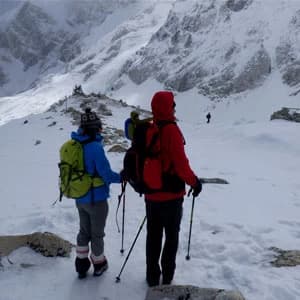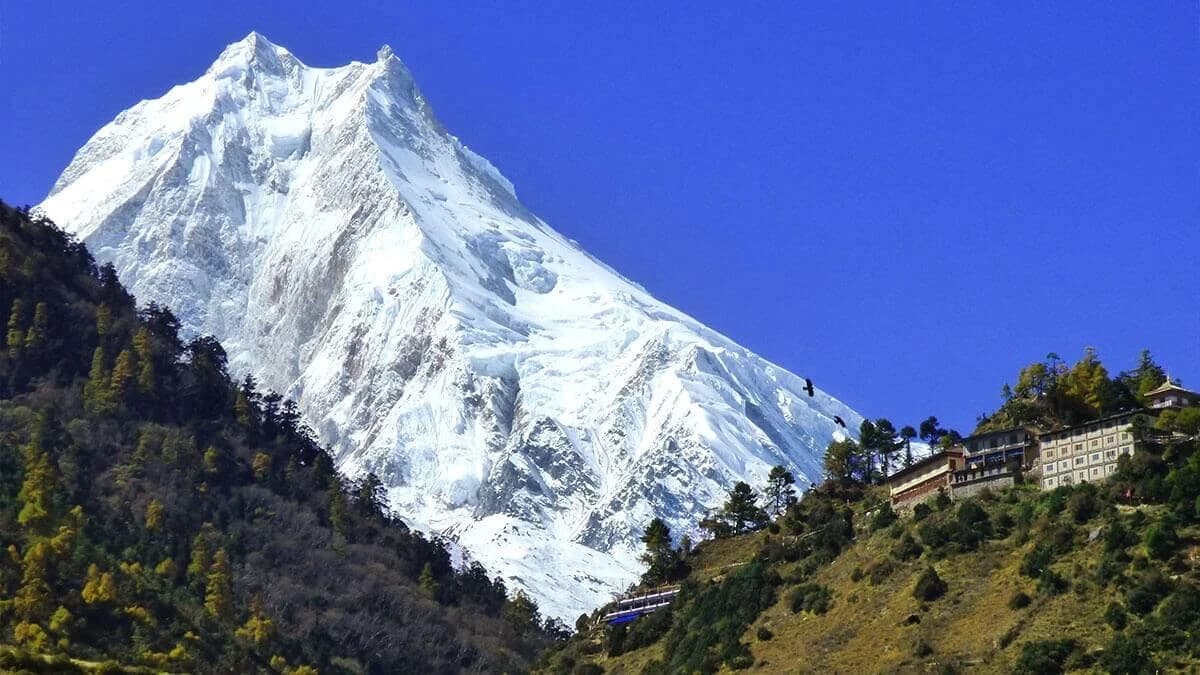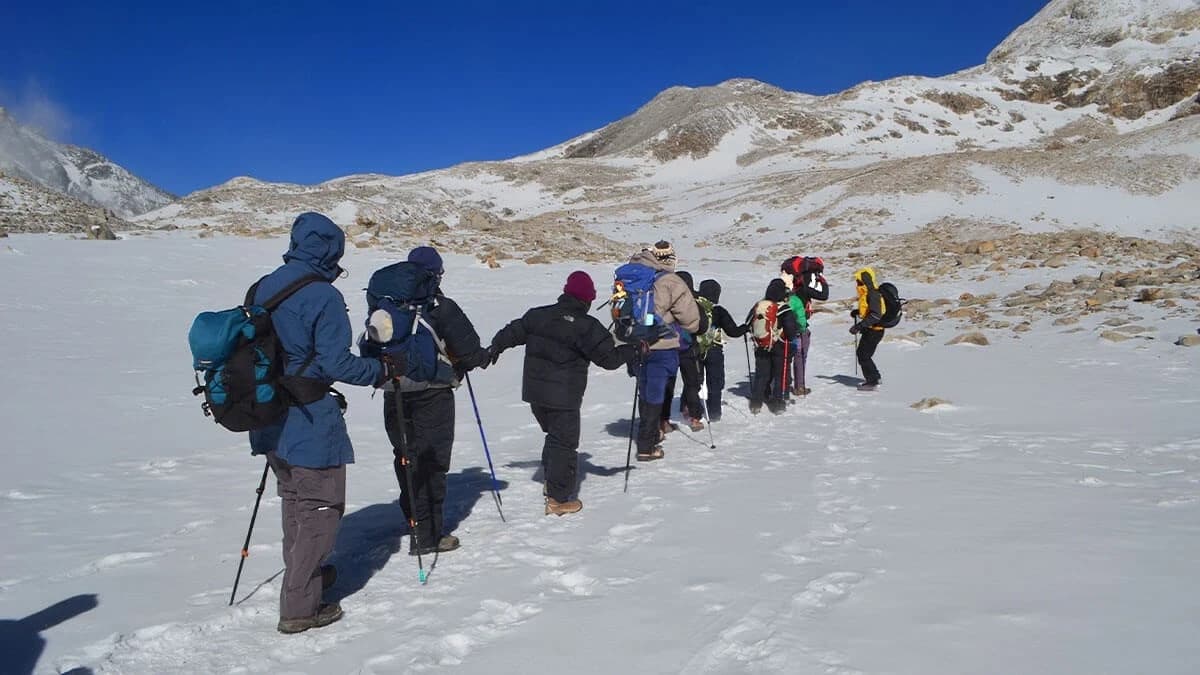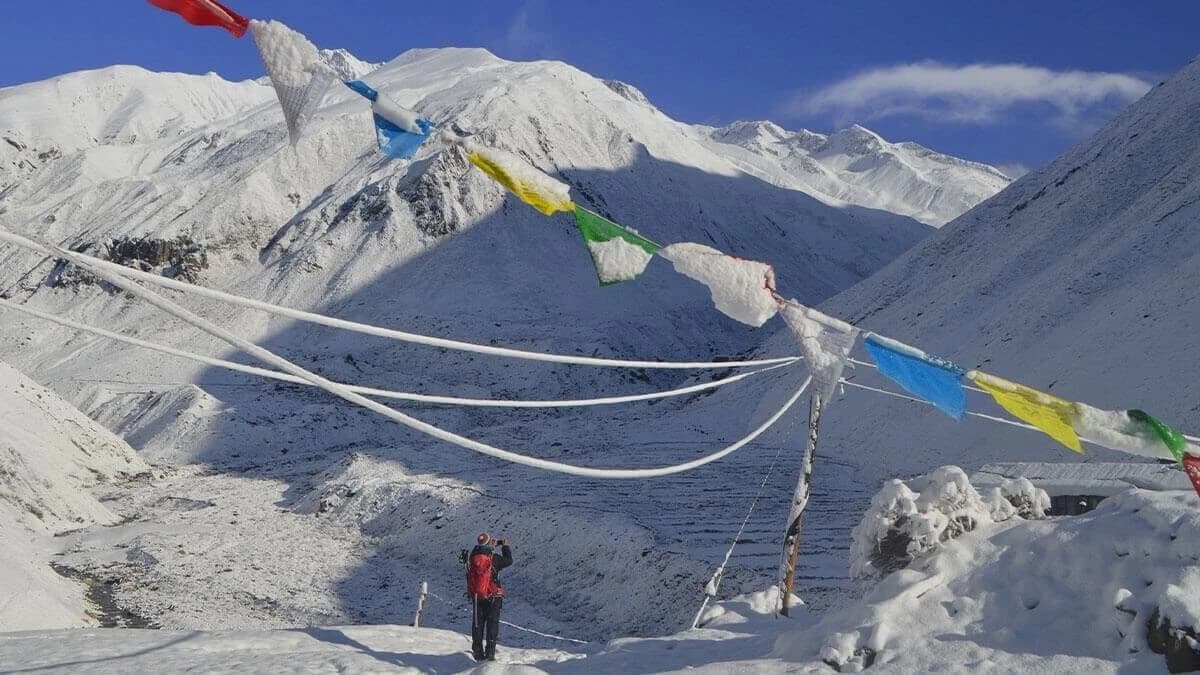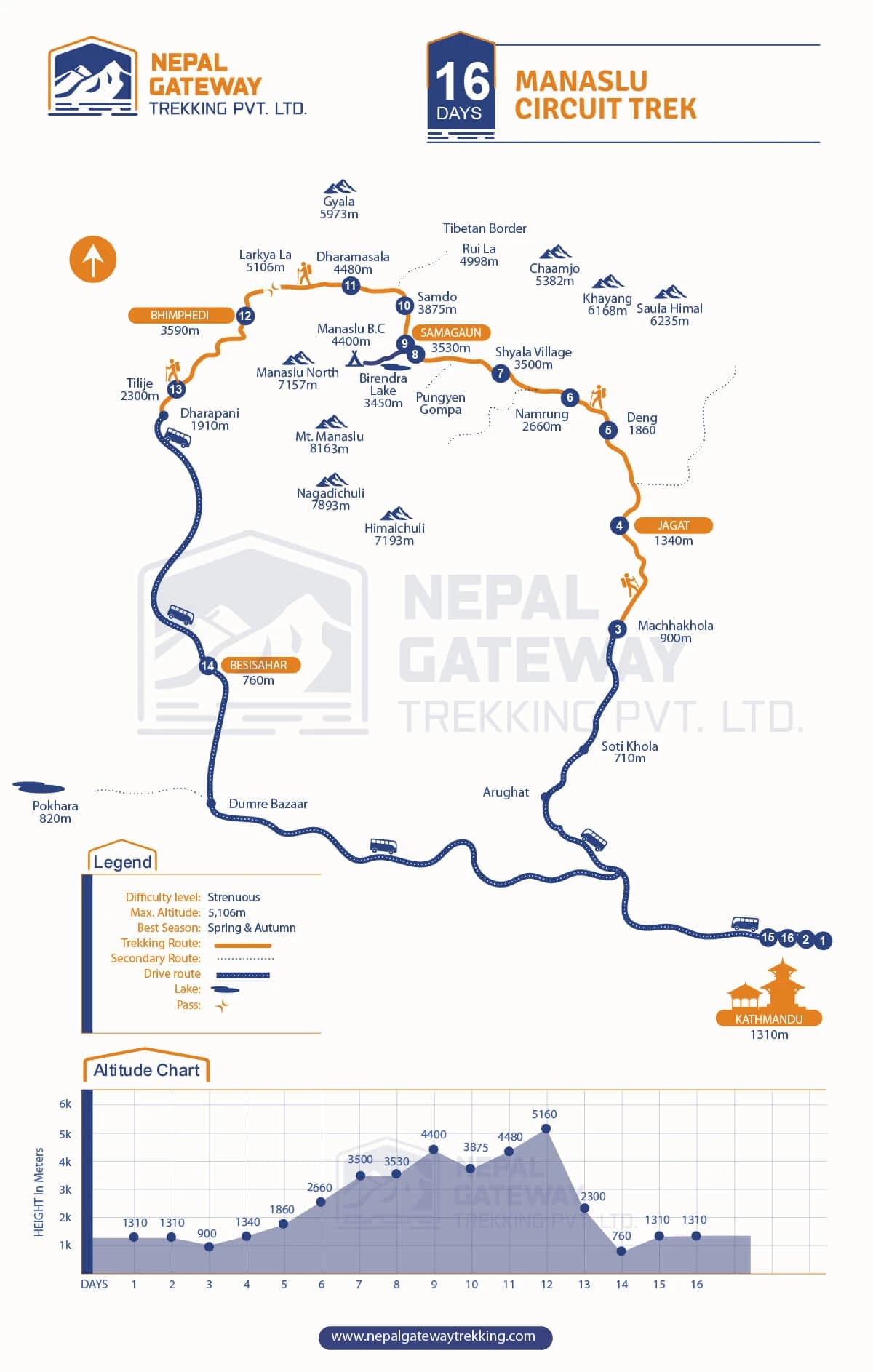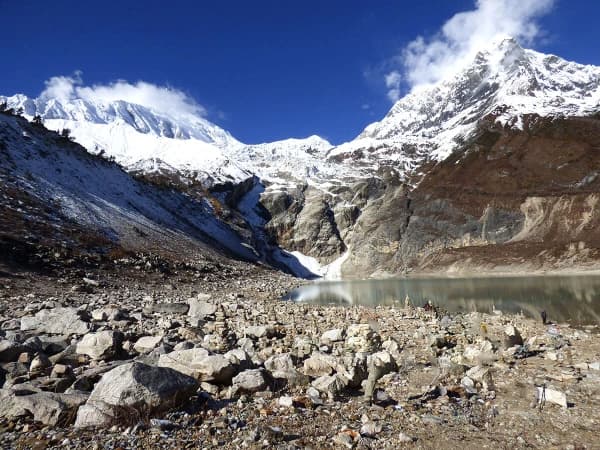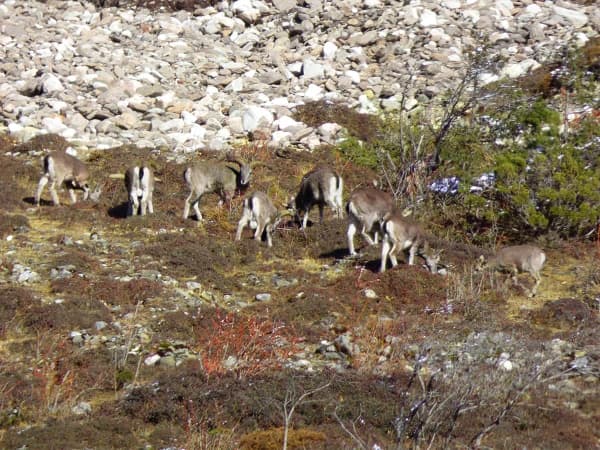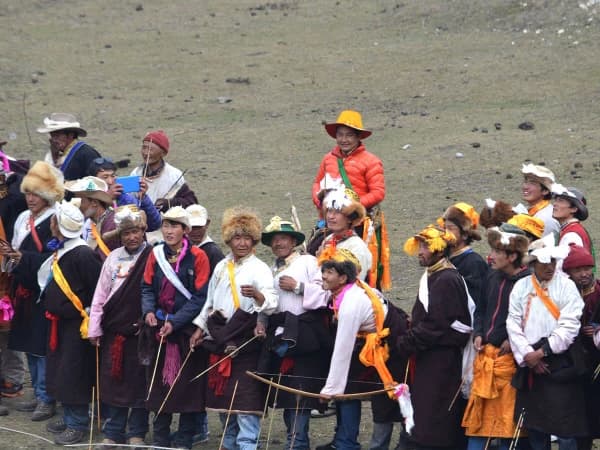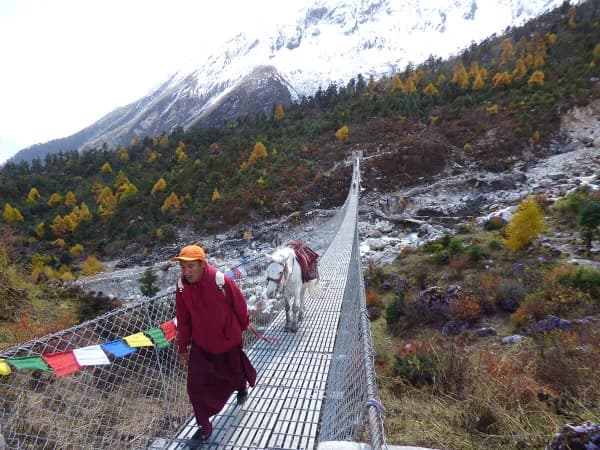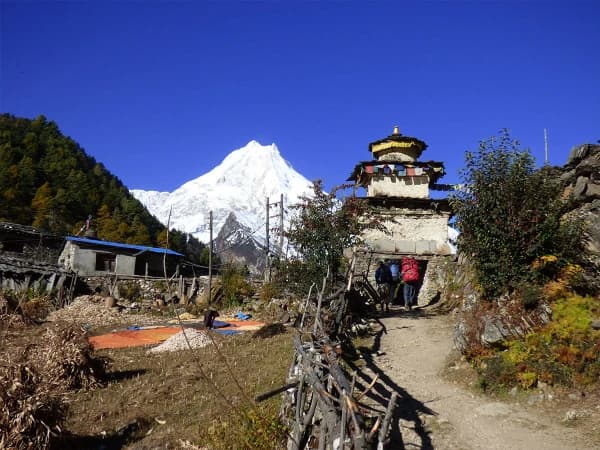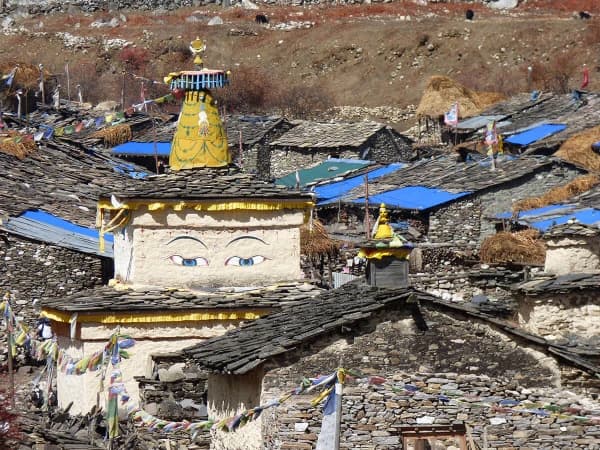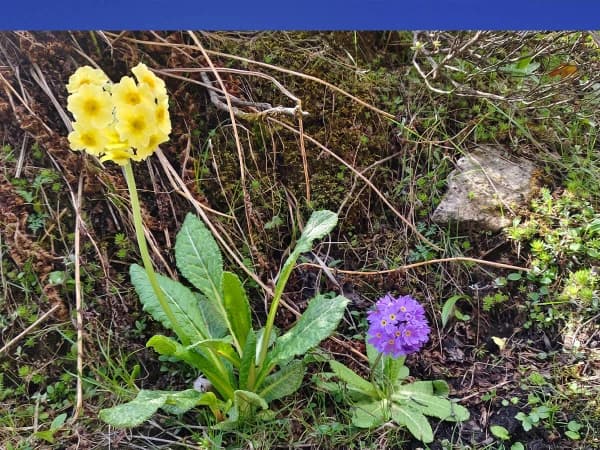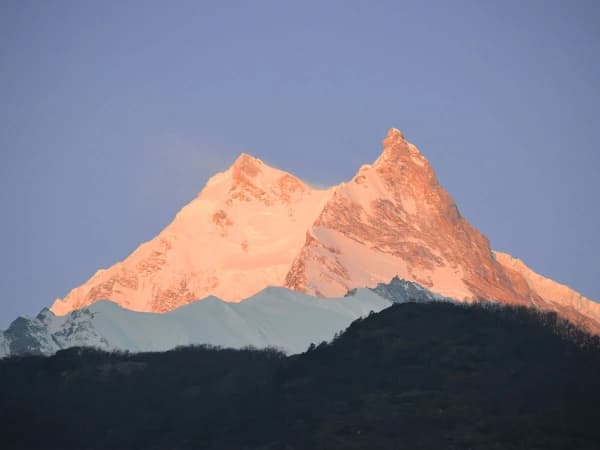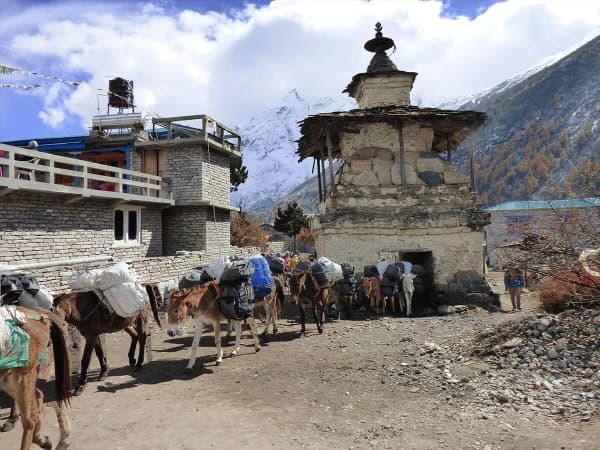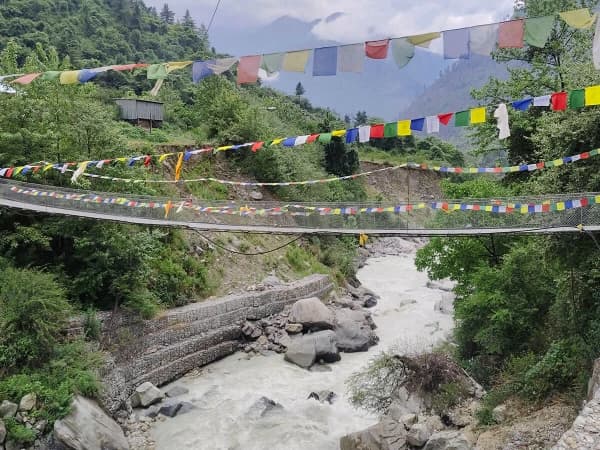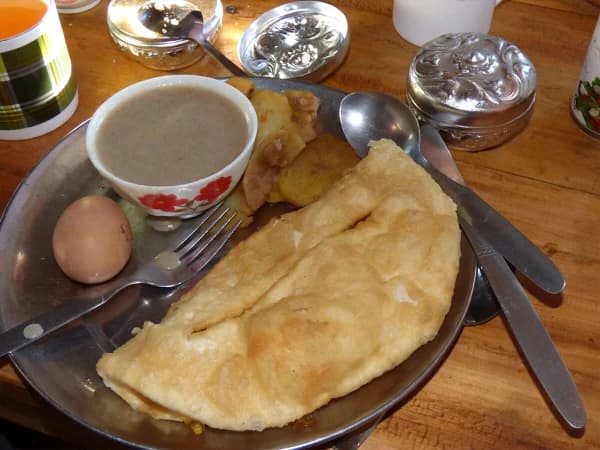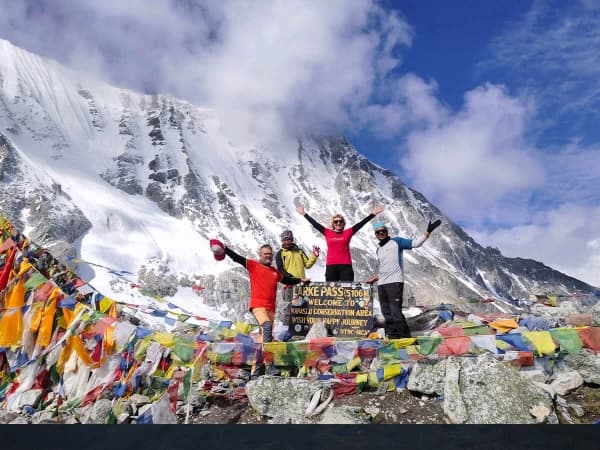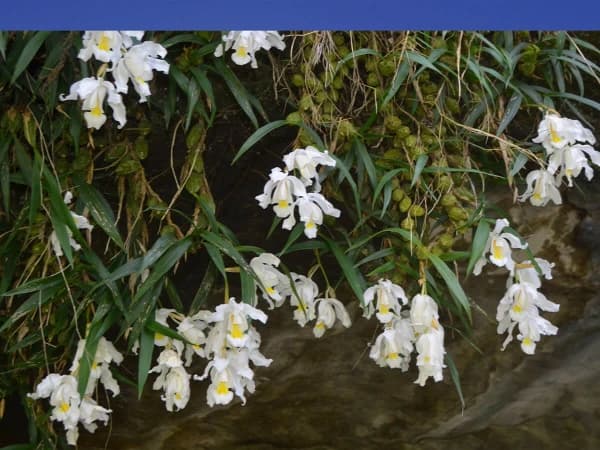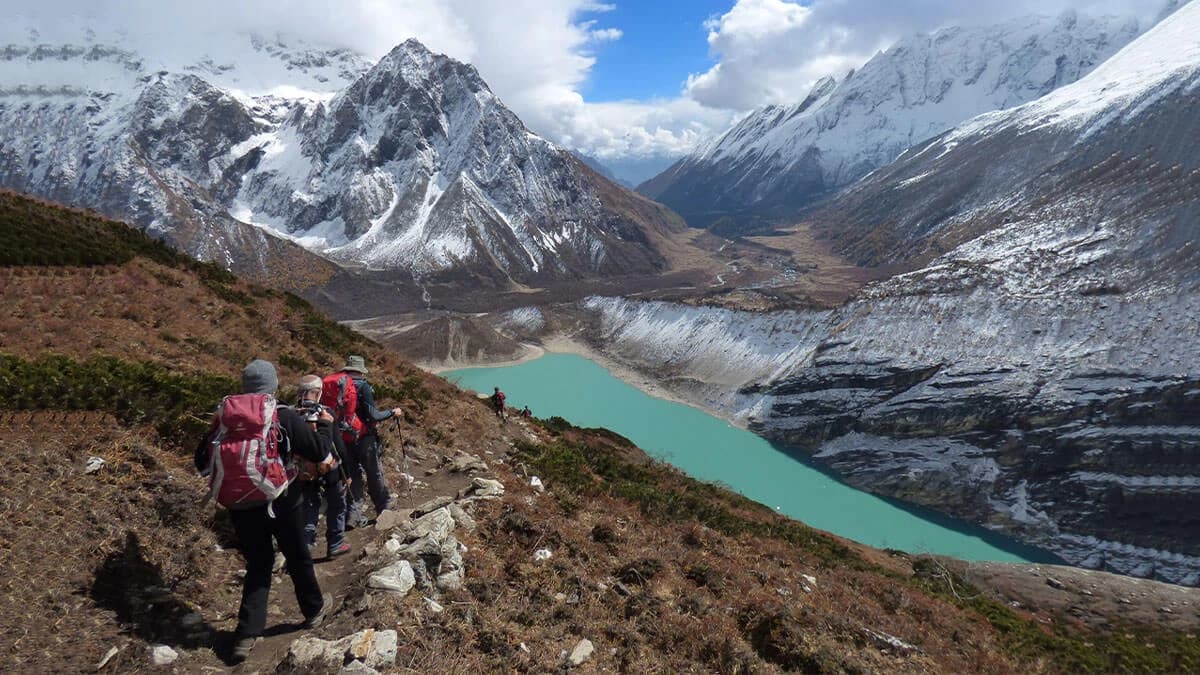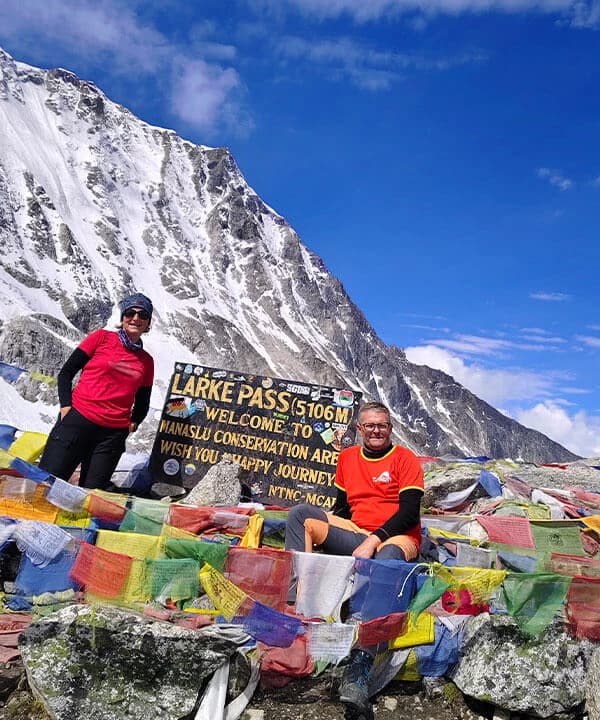If you are looking forward to escaping to the Himalayas for an off-the-beaten-path adventure with an incredible view of Mount Manaslu, lace your boots for this beautiful Manaslu Circuit Trek.
Manaslu Circuit Trek
Manaslu Circuit trek is one of Nepal’s spectacular yet less crowded trekking adventures. Located in the remote Gorkha district, this incredible journey takes you around Mt. Manaslu, the world’s eighth-highest peak at 8,163 meters. The Manaslu region is famous for its untouched natural beauty and genuine mountain culture.
This trekking route was opened for foreigners in 1991 after being completely restricted due to its proximity to the Tibetan border. Today, the Manaslu trek attracts thousands of trekkers annually while maintaining its remote wilderness character through restricted permit requirements.
The Manaslu Conservation Area, established in 1998, covers 1,663 square kilometers, including different ecological zones. The major highlight of the Manaslu circuit trek itinerary is crossing diverse ecosystems ranging from subtropical forests to alpine meadows and glacial landscapes. The Manaslu Circuit goes through rhododendron forests, creating splendid displays during spring, while pine, fir, and juniper trees dominate higher trails.
The region is also home to rare wild species like snow leopards, Himalayan black bears, red pandas, and blue sheep. Bird watchers can observe numerous species, including Himalayan pheasants and colorful mountain birds.
The Manaslu Circuit hike offers rich cultural experiences with diverse ethnic communities. Lower regions feature Hindu and Gurung communities. These people mainly practice traditional farming for their living. Higher up the valley, Tibetan Buddhist culture dominates, with ancient monasteries, prayer flags, and mani walls creating a spiritual atmosphere.
Samdo and Samagaun strongly demonstrate Tibetan culture with traditional stone houses and Buddhist practices preserved for centuries. Local people in the higher valley practice agriculture, animal husbandry, and trade with Tibet. Thus, you’ll get a glimpse into sustainable mountain living practices developed over generations.
The Major Highlights of Manaslu Circuit Trek
- Trek through the restricted Manaslu Conservation Area with special permits.
- Cross the challenging Larkya La Pass at 5,106 meters—the trek's highest point.
- Enjoy spectacular views of Mt. Manaslu (8,163 m), the world's eighth-highest peak.
- Witness impressive mountain panoramas, including Himal Chuli, Ganesh Himal, and Annapurna II.
- Trek through diverse landscapes from subtropical forests to alpine meadows.
- Optional hike to Manaslu Base Camp at 4,800 meters for ultimate mountain views.
- Explore the peaceful Birendra Lake, just 45 minutes from Samagaun.
- Visit ancient monasteries and gompas, including the revered Pungen Gompa.
- Experience less crowded trails compared to the popular Everest and Annapurna routes.
- Complete Nepal's most challenging circuit trek with professional guide support.
- Explore historic salt trading routes between Nepal and Tibet.
- Interact with local communities following Bhotia, Gurung, and Sherpa heritage.
- Experience authentic Tibetan Buddhist culture in remote mountain settlements.
Route Overview of Manaslu Circuit Trekking in Nepal
The Manaslu Circuit trip begins with your arrival at Kathmandu International Airport. You'll spend an extra day in the capital city to prepare and obtain the necessary permits. On the third day, you'll drive to Machha Khola via Arughat and Soti Khola.
This marks the official start of the hiking adventure to the Manaslu Circuit. Machha Khola, located in the Budhi Gandaki Valley, gets its name from the nearby fish stream. This Gurung settlement is the gateway to the 16-day Manaslu Circuit trekking itinerary.
The Manaslu trail leads you through diverse landscapes, making each day fascinating for nature lovers. From Machha Khola, you'll trek to Jagat. Here you'll present the Manaslu Circuit trekking permits to enter the Manaslu Conservation Area.
The trail continues through traditional hamlets like Salleri, Siridibas, and Phillim. Pass the Tsum Valley junction at Pewa village before reaching Deng. The course continues through hamlets dominated by Tibetan Buddhist culture to reach Namrung, a historic stop on the ancient Tibetan salt routes.
As you progress on the Manaslu circuit trekking route, the Tibetan influences become more apparent. Hiking on the Manaslu trail takes you through Lhi village to Shyala, one of the largest settlements in the conservation area. The path has frequent stupas, prayer flags, and mani walls reflecting the rich Buddhist heritage.
As you walk to Samagaun, stop in the middle to explore the ancient Pungen Gompa monastery. This monastery offers insights into Tibetan-influenced Buddhist culture and awe-inspiring alpine and glacial views.
Samagaun is an acclimatization base before tackling the challenging sections ahead. This rest day is essential for adjusting to the thin air. There is an option for side trips, such as the easy walk to Birendra Lake or the more strenuous Manaslu Base Camp hike. Both options reward you with splendid mountain views.
After proper acclimatization, the Manaslu trek continues to Dharamsala via Samdo, also known as Larke Phedi. This temporary settlement accommodates Manaslu trekkers preparing for the demanding Larkya La Pass (5,106 meters) crossing.
Conquering Larkya La Pass represents the major highlights of the 16-day Manaslu Circuit trek itinerary. From this challenging Himalayan pass, you'll enjoy breathtaking sights of Cheo Himal, Gyaji Kung, Himal Chuli, Himlung Himal, and, on clear days, even Annapurna II. Afterwards, descend to Bhimtang, where you'll catch sight of the magnificent Pungkar Tal (also sometimes spelled Ponkar Tal) glacial lake.
The final stages take you through Tilije into the Annapurna Conservation Area. Finally, you reach Dharapani village, the starting point for the Annapurna Circuit trek. This creates an exciting meeting point where Annapurna Circuit and Manaslu Circuit trekkers meet before returning to Kathmandu to conclude an epic Himalayan journey.
Why Choose Nepal Gateway Trekking for the Manaslu Circuit Trek?
- Legitimate and Registered Travel Agency: We have a valid registration with Nepal's Department of Tourism. Our organization is proud to be a member of TAAN (Trekking Agencies' Association of Nepal) and NMA (Nepal Mountaineering Association). This ensures you trek with a trusted and authorized operator.
- Experienced Licensed Guides and Porters: Our team includes government-licensed guides who have received high-altitude trekking training and are adequately trained in first aid. Every guide has extensive experience in the Manaslu region. Our porters have also received extensive training and are prepared for mountain conditions.
- Safety First Approach: Your safety is our top priority. We maintain strict safety protocols and emergency evacuation plans. Our staff carry communication devices and have access to medical support. All our team members are covered by comprehensive insurance for high-altitude trekking.
- Transparent Pricing Policy: Honest pricing with no hidden fees is what we stand for with our transparent pricing policy. All costs are disclosed upfront. If additional expenses arise, we'll inform you immediately before the trek begins. No surprises, no last-minute fees.
- Flexible Itinerary Options: We provide detailed day-by-day plans that include proper acclimatization days. We can customize our itineraries depending on your interests, fitness level, interests, and time availability. We include backup plans for weather delays or medical emergencies.
- Committed to Responsible Tourism: We promote environmentally friendly trekking practices and assist local communities in growing. We follow the Leave No Trace principles. All employees are treated fairly and paid appropriately by our team. We urge our customers to travel responsibly.
- 24/7 Support and Communication: We provide clear guidance on visas, permits, gear, and trip preparation. Our team maintains constant communication throughout the trek. You'll receive prompt responses to all queries before and during the adventure.
- Complete Legal Documentation: We handle all necessary permits, including TIMS, restricted area permits, MCAP, and ACAP. All documentation is processed properly with official receipts provided. No permit issues or last-minute complications will delay the trek.
Itinerary
This is our standard and recommended itinerary for the Manaslu Circuit Trek.
As you step out of Kathmandu International Airport, a Nepal Gateway Trekking representative will welcome you. After having a short introduction, you'll be transferred to the hotel in a private vehicle. After freshening up, head out and stroll around nearby places—lively streets, colorful shops, and warm Nepalese people will provide you a glimpse into the capital city.
This is an excellent opportunity to review your gear and equipment for the upcoming adventure. If you're missing anything essential, visit local shops and markets to make necessary purchases. Later, rest, relax, and get mentally ready for tomorrow's start of your Manaslu Circuit trek.
Today is a day of rest, acclimatization, and getting used to Nepalese culture, traditions, and lifestyles. After breakfast, visit our office to attend the trip briefing session. If you join a group, you'll meet the trek guide and fellow trekkers.
During this session, the guide will explain all trekking details of the Manaslu circuit trip and review your trekking equipment. He will discuss the itinerary in detail; you can express any concerns.
Later, they will arrange the Manaslu trekking permit for an upcoming adventure. Since the Manaslu circuit lies in the restricted area of Nepal, you need to obtain a restricted area permit, which might require an extra day in the city. These special permits are essential for hiking to the Manaslu Circuit as the region is protected and requires official documentation.
Once you finish the trip briefing and the permits are done, start packing for the Manaslu adventure. Take time to organize your gear and double-check that you have all the essential gear. After dinner, get a good night's sleep as you want to feel fresh for tomorrow's journey. This preparation day is crucial for a successful and safe trekking experience in the restricted region of Nepal.
Early morning, you'll drive northwest to reach Machha Khola, a riverside village in the remote Budhi Gandaki Valley. The drive is long, but the scenic countryside view keeps it interesting. At the beginning, the road conditions are fine. But as you get closer to your destination (Machha Khola), the road starts to get bumpy and rough alongside the steep banks of the Budhi Gandaki River.
The starting point of the 16-day Manaslu Circuit trek is Machha Khola. Enter the Gorkha district and pass through Arughat and Soti Khola along the way. In the final sections, the road passes through some landslide areas that require careful driving. As you approach the trek's beginning point, the journey offers glimpses of rural Nepalese life and astounding mountain scenery.
Machha Khola is a large settlement perched on the banks of the Budhi Gandaki River. This place got its name from the nearby "Fish Stream" and is mainly inhabited by Gurung people. It is a peaceful entry point to the Manaslu region, providing basic accommodation and trekking facilities. The surrounding atmosphere gives you the first taste of mountain culture before starting the trekking adventure.
Begin the Manaslu trek from Machha Khola along towering cliffs. The Manaslu trekking trail starts muddy and slippery but offers outstanding valley views. Walk through dense forests and charming Gurung hamlets like Khorlabeshi. Continue to Tatopani, a lovely settlement above the river, before crossing the Budhi Gandaki on a wire suspension bridge.
The path winds through thick jungle with lush vegetation on rolling terrain. Enticing waterfalls cascade down massive rock faces across the river— a common sight while trekking to the Manaslu Circuit. The final hours involve stone steps through trees as the valley widens and the river calms.
After crossing the final suspension bridge, catch the first glimpse of Jagat. You officially enter the Manaslu Conservation Area, where officials check your Manaslu Circuit trekking permits at the checkpoint. Jagat is an important stop on the Manaslu circuit route and serves as the gateway to the protected conservation area. The village got an eye-pleasing sight with clean flagstone paths and traditional Gurung homes.
Start the day walking to Salleri and descending to Siridibas on the Manaslu route. Today's path offers expansive valley views, cascading waterfalls, small hydropower stations, and rustic hamlets with snowy peaks in the distance. The trail features numerous gompas and colorful Buddhist prayer flags, highlighting the strong Buddhist culture along the Manaslu trek. Continue to Philim village, where officials check permits before walking along the western riverbank.
The lower section of the Manalsu circuit trail becomes picture-perfect with unique rock sculptures carved naturally by river water along the banks. Leave the riverside to enter the beautiful forests of rhododendron and pine trees. Cross the Siyar Khola bridge and reach a critical junction where the trail to Tsum Valley branches off to your right. Continue through this scenic terrain toward Pewa village.
A short walk from Pewa brings you to Deng, surrounded by thick woodlands and towering mountains. Mani walls and chortens in this area reflect the predominant Tibetan Buddhist culture. Upon arrival in Deng, immerse yourself in the tranquil Himalayan atmosphere. Discover the rich cultural aspects of the Manaslu trek as you settle into an authentic mountain community.
Start the trekking journey to Namrung by walking along the west bank of the Budhi Gandaki River. After walking for a while, you'll cross a suspension bridge. The trail continues east for about four hours until you reach Ghap village for a lunch break.
After Ghap, the path passes through several landslide-prone areas before leveling out for an hour. Enter dense forests of fir and rhododendron trees that showcase the stunning beauty of the Manaslu circuit trek's lower elevations.
The trail follows the northern riverbank, passing very close to the mighty water flow. After crossing a bridge, start a steep ascent to Namrung on concrete steps carved into the route, making the climb manageable and enjoyable. As you approach Namrung, you'll see very long mani walls with Tibetan mantras carved in stone. The village sits on the edge of the Nubri/Nupri region, where locals follow Bhotia and Gurung heritage, mixed with Sherpa, Rai, and Tamang ancestries.
Namrung is a charming settlement that once served as a primary path for Tibetan salt routes in the Manaslu region. Just outside town stands a huge waterfall that adds to the scenic beauty. The village offers several comfortable teahouses with reasonable accommodation and food options. The Manaslu circuit trek offers a genuine cultural experience at this historic settlement.
Start the day with a pleasant walk through forested trails. The path crosses the wooden bridge, which you must traverse to arrive at the welcome gate into the Chumnubri area. Enjoy striking views of mighty Himalayan peaks, including Shringi, Ganesh Himal, and Himal Chuli.
Continue along the Manaslu trail through Bhaniam village, walking alongside barley fields. Enter a scenic section passing through pine forests surrounded by tall cliffs with massive waterfalls on both sides.
Reach the top of the ridge to arrive in Lhi village, where you can explore a small, colorful gompa draped in prayer flags. The Tibetan influence becomes more evident while trekking on the Manaslu circuit with frequent stupas, prayer flags, and mani walls. After an hour, begin a gentle switchback climb to a small ridge. From this viewpoint, continue climbing gently as you pass Shyo and other small hamlets on the way to your destination.
Shyala is one of the largest settlements within the Manaslu Conservation Area, offering plenty of teahouses and lodges for trekkers. The village features a big prayer wheel and the large Shree Lho Primary Syala school.
On the hilltop stands another large gompa with alluring views of surrounding peaks, including Mt. Manaslu, Nadi Chuli (Peak 29), and Himal Chuli. Shyala is a perfect place to experience culture and mountain scenery during the Manaslu circuit trekking adventure.
Today's trek leads to Samagaun, located near the foot of Mt. Manaslu and serving as the key entry point into the Upper Nubri region. The trekking distance from Shyala to Samagaun is relatively short with no significant elevation jumps along the Manaslu circuit trail. Visit Pungen Gompa, at the end of the Pungyen Valley, for a rewarding side trip.
Explore the iconic Pungen Gompa, one of the Manaslu region's oldest and most revered Tibetan monasteries. View the surrounding alpine meadows and glacial streams from this sacred monastery. This spiritual site is a memorable cultural highlight of the Manaslu trip, as this place offers a serene atmosphere and ancient architecture. The monastery provides insight into the deep Buddhist traditions that define this remote mountain region.
Samagaun, also known as Sama Gaun, is a large and culturally rich settlement. On the Manaslu circuit trail, this is the major place where most trekkers stop for acclimatization. Local life revolves around agriculture, animal husbandry, and growing tourism activities.
This region is a popular base for trekkers who must acclimate before heading to higher altitudes. There is also a police checkpoint where you must show special Manaslu trekking permits before continuing.
Today is a crucial Sama Gaun acclimatization stop along the Manaslu circuit route before heading toward the challenging Larkya La Pass. Your body needs time to adjust to the thin air at this altitude. During this rest day, explore Sama Gaun and nearby viewpoints through several side trip options that follow proper acclimatization strategies.
The easiest and most popular option is a side trip to Birendra Lake, just 45 minutes from Samagaun. This small freshwater lake sits at 3,691 meters near the Manaslu glacier. The trail goes straight up to Samagaun monastery and through fields to reach the lake base.
You can sit peacefully around the lake and enjoy the serene mountain atmosphere. For a more challenging adventure, consider Manaslu Base Camp hiking, which takes 6-7 hours and reaches 4,800 meters.
The hike to Manaslu Base Camp offers magnificent mountain scenery while helping you acclimatize properly. From the base camp, admire commanding views of the Manaslu glacier and surrounding peaks, including Himal Chuli, Ganesh Himal, Shringi Himal, and Mt. Manaslu.
During spring, there is a high chance of meeting climbers preparing for the Manaslu peak expedition. After exploring these options, return to explore Samagaun and rest for tomorrow's trek toward higher elevations.
The trek to Samdo is an easy and pleasant hike on the Manaslu circuit trek, following the river deeper into the valley through vast grassy fields and shrublands. Samdo village lies very close to the Tibetan border, where the scenery becomes more dramatic with mountain landscapes and stark, arid valleys.
This border region features Tibetan settlements where culture, language, and practices remain closely tied to Tibetan heritage. Ancient trade routes and spiritual significance with monasteries and gompas mark the area.
Trekking from Samagaun to Samdo is a short day's journey while hiking on the Manalsu circuit trail. En route, pass an enormously long mani wall that frames the path ideally below the mighty peak of Pangpoche Himal. Enjoy amazing sights of grazing yaks and marmots scurrying through the fields. A little ahead, with the help of a small wooden bridge, you cross the river and take an uphill climb to reach Samdo.
Samdo is a small, picturesque hamlet that welcomes you with a white stupa. People living here are primarily focused on yak herding. Offering a limited number of lodges, it is a crucial stop near Larkya La Pass. You can rest, explore the village, or hike to Samdo Peak upon arrival.
Notice the Larkya La trail on the left side above the valley, where you can see the main track for Tibet over Larjyang La forming slopes on the Larkya La Pass trail. This strategic location makes Samdo perfect for preparing for the challenging path ahead.
Today you'll trek one step close to Larkya La Pass to reach Dharamsala, also called Larke Phedi. This rest stop is built to accommodate trekkers attempting to cross the challenging Larkya La Pass, one of the highest and most demanding sections of the Manaslu trek. Today's trek from Samdo to Dharamsala is a short three-hour hike passing through Larkya Bazaar and its tiny hydropower station.
Although Dharamsala seems within arm's reach from Samdo, the altitude greatly challenges today’s journey. Try to enjoy this adventurous day with scenic views of the Himalayan chain. Relish sublime views of Naike Peak, Manaslu, and the mighty Syacha Glacier. Remember to monitor your body signs properly while trekking to Dharamsala, as the high altitude can affect different people differently.
At Dharamsala, there are very basic lodges and huts where trekkers rest, recover, and prepare for the upcoming strenuous crossing of Larkya La. The surrounding landscape is stark and alpine, with serene views of the peaks and glaciers. Due to high altitude and remote location, expect harsh weather conditions. Despite this, it serves as an essential acclimatization stop for those navigating the demanding terrain of the Manaslu circuit.
Day 12 of this Manaslu circuit trek itinerary is the major highlight— crossing the Larkya La Pass at 5,106 meters. Wake up before dawn around 3:00 AM, quickly grab breakfast, and hit the trail with your headlamp. The trail begins with a gentle climb over nearby hills before joining the edge of Larkya Moraine over rocky ground. Walk slowly to arrive at a small tea shop where you can take a short break and catch your breath.
Continue walking on rocky terrain that gradually turns into a deep snow trail beside the mighty Larkya Glacier. In the midway, reach a flat area with frozen lakes around. From this point, you get a sight of colorful prayer flags in the distance that signify the pass.
After walking for nearly 3-4 hours, you reached the Larkya La Pass, the highest point of the Manaslu Circuit. Enjoy a short celebration and staggering views of high mountains, including Cheo Himal, Gyaji Kung, Himlung Himal, and sometimes Annapurna II on clear days.
After the pass, the path begins easily but quickly steepens. If there is snow, use micro spikes to avoid slipperiness. The scenery enters the Manang region with jaw-dropping sights of glacial valleys and crystal-clear Pungkar Tal in the distance.
After descending to the glacial valley, the track becomes much easier and widens gradually before arriving at Bhimtang village. This marks the completion of the most challenging and rewarding day of the major highlight of the Manaslu circuit trek.
The second last day on the Manaslu circuit trip departs from Bhimtang, descending toward the Dudh Khola. From this point, you enter the Annapurna Conservation Area. The trail becomes a long descending path that is very scenic and comfortable after the challenging previous days.
Notice the dramatic change in landscape from alpine terrain to dense rhododendron and fir forests, marking an entry into the Annapurna Conservation Area. Continue through the forest trail to arrive at Gurung Goa, the first village you'll encounter since Samdo. This marks a return to more populated areas with local communities and traditional mountain life.
The trail becomes greener as you continue the hike through fields and groves of oak and rhododendron. To get to Tilije, a pleasant green hamlet with a peaceful vibe, follow the north bank. The village provides comfortable lodging options and marks the near completion of your memorable Manaslu circuit adventure.
Today is the last short walk to Dharapani on the Manaslu circuit trek. Walk down to the Dudh Khola bridge and enter the Marshyangdi Valley. A little walking ahead of Tilije brings you to Thonje village. From here, descend a stone-paved route alongside a small settlement toward the final trekking destination.
As soon as you reach Dharapani, you arrive at the junction of the Annapurna Circuit path, where you must pass through another security check. Dharapani is the starting point for the Annapurna Circuit trek, making it a busy town full of trekkers.
To get to Besisahar, take a jeep from Dharapani. The road passes through the steep hills and narrow mountain paths. After several hours of a rough yet scenic ride, you reach Besisahar. Here, your Manaslu circuit trek officially ends.
Today, the trekking journey to the Manaslu region ends with driving back to Kathmandu. The Besisahar to Kathmandu ride takes 6 to 7 hours on the winding mountain roads. The drive is full of excitement and offers one last opportunity to soak in the beauty of the Nepalese countryside as you leave the mountains behind.
After a long road trip, check into your hotel when you arrive in Kathmandu and rest. Later, stroll around Thamel, where gift shops offer souvenirs for your loved ones. Enjoy dinner at one of the finest restaurants and try authentic Nepali cuisine. One final day in the capital city, enjoy the vibrant atmosphere as you celebrate your successful mountain-climbing trip
On the final day in Nepal, enjoy a leisurely breakfast and prepare to depart for the airport for your international flight. It's recommended to arrive 3 hours before the flight departure time. Suppose your flight is scheduled for late afternoon or evening.
In that case, you'll have time to explore Kathmandu city for last-minute shopping or sightseeing. When you're ready, a staff member from Nepal Gateway Trekking will drop you off at the airport for departure.
We wish you a safe journey and hope to see you again soon for another adventure. Please remember us if you plan to visit Nepal, Bhutan, or Tibet. We'll organize a trip according to your preferences and requirements. We appreciate you choosing us for your memorable Manaslu circuit adventure and hope you'll carry wonderful memories of Nepal.
Dates & Availability
Private tripCost Includes
- Complimentary airport pickups and drop-offs by private vehicle.
- All ground transportation as per itinerary by private car, local buses, and Jeep.
- Three nights’ accommodation at a three-star category hotel in Kathmandu, inclusive of breakfast.
- Three meals (breakfast, lunch, and dinner) during the Manaslu Circuit Trek.
- Twin sharing accommodations (common bathroom) during the Manaslu hike.
- One highly experienced English-speaking, friendly trekking guide, including his expenses.
- Required porters (1 porter between 2 people), including their expenses.
- Special Manaslu Circuit Trek permit.
- Annapurna and Manaslu conservation area permits. Please bring two passport-size photos for the permit.
- Manaslu Circuit Trekking Map.
- Nepal Gateway Company T-shirt.
- Nepal Gateway Trekking Company bags for trekking.
- Local fresh fruits (apples, bananas, pears, oranges, pomegranates, etc.) were served as desserts after dinner during the trip.
- First aid kit with an oximeter to monitor oxygen levels and heartbeats regularly.
- Evacuation assistance, if needed.
- All necessary government taxes.
- Office service charges.
Cost Excludes
- Lunches and dinners in Kathmandu.
- Your travel insurance.
- Nepal entry visa fee.
- Your international flight ticket to/from Kathmandu.
- All kinds of hot drinks (teas, coffees, and hot waters) during the Manaslu Circuit trek.
- Cold drinks (mineral water, Coke, Sprite, and Fanta) and alcoholic beverages on trekking.
- Your personal nature expenses, equipment, and medical kit.
- Hot shower, internet, and phone call unless it is free.
- Donations to schools, monasteries, etc.
- Battery charging fees for cameras, mobile phones, laptops, etc.
- Snacks and desserts (apple pies, chocolate pies, chocolate bars, etc.).
- Tipping to field staff. (Tipping is not mandatory but expected.).
- Extra accommodations in Kathmandu.
Good To Know
Manaslu Circuit Trek Cost
A standard 16-day Manaslu trek package costs between $1090.00 to $990.00 per person. This all-inclusive cost covers everything you need for a smooth and unforgettable Manaslu trekking experience. The Manaslu trek price includes an experienced guide, comfortable teahouse accommodations, three meals a day, all necessary permits- ACAP, MCAP, and the restricted area permit, and ground transportation.
A Manaslu trip's price depends on several variables, such as preferred trekking style (budget-friendly vs. luxury services) and the chosen season. Peak season treks generally incur higher costs than those during the off-season. Additionally, group size matters because larger groups enjoy better rates per person.
The standard package includes guide and porter services, ground transportation, and teahouse accommodation along the route. However, the cost to spend a Manaslu Circuit trek doesn't cover certain additional expenses. You must budget separately for hot showers, device charging, Wi-Fi access, and personal purchases during the trek.
Tips for a guide and porter are customary and greatly appreciated team. The Manaslu circuit trek cost does not include personal expenses, like extra snacks, drinks, and souvenirs are not included in the base cost. Prepare yourself for these additional expenses, which save you from any financial surprises during the trek.
Manaslu Circuit Trekking Permits
As the Manaslu region lies in the restricted area of Nepal, you need several necessary permits. Unlike other trekking routes in Nepal, this route requires an additional restricted area permit. Likewise, you can't trek solo as it lies in a restricted zone.
To obtain all necessary trekking permits for the Manaslu circuit trek, you must seek help from a registered trekking agency like Nepal Gateway Trekking. They will help to get all permits on your behalf; you need to submit the required documents.
The restricted area permit for Manaslu Circuit trek is the most critical document. It is mandatory for the section between Jagat and Dharapani. Manaslu Circuit restricted area permits costs depend on the time of year:
- September to November: USD 100 per person for the first seven days, and USD 15 for each additional day.
- December to August: USD 75 per person for the first seven days, and USD 10 for each additional day.
Additionally, you need the MCAP permit (Manaslu Conservation Area Permit) costing NPR 3,000 (approximately USD 25) per person. This permit is required from Philim, where the conservation area begins. The ACAP permit (Annapurna Conservation Area Permit) is also necessary, costing NPR 3,000 (approximately USD 25) per person, as the trek crosses into the Annapurna Conservation Area after Larkya La Pass.
Essential documents to process the Manaslu trek permit include two passport-sized photographs for each permit application. These permits are valid for a single entry only and are non-refundable. If you plan to visit Tsum Valley, an additional restricted area permit with seasonal pricing similar to the main Manaslu permit is required. Note that TIMS cards are not necessary for this trek.
Best Time for Manaslu Circuit Trek
The best time for the Manaslu trek is autumn (September to November) and spring (March to May). These seasons offer the safest trekking trails, the best weather, and unobstructed mountain scenery. Because of their unique advantages, each season is ideal for different preferences and experiences.
The best time to trek Manaslu Circuit is Autumn/fall, which runs from September to November. Mild temperatures and clear skies define the stable weather. With post-monsoon conditions, Mt. Manaslu and the surrounding peaks are visible. The trails are dry and safe with minimal landslides or snow blockage risk.
This season also coincides with major Nepalese festivals, adding cultural richness to the Manaslu trek. However, expect more crowds on the Manaslu trails and in teahouses. Early September may still have occasional rainfall, so come prepared.
Spring (March to May) is another excellent choice for the best time to do Manaslu Circuit trek. The weather is pleasant with mild, warm days and cool nights. Mountain views are eye-dropping with fresh snow on peaks in winter. The forests come alive with blooming rhododendron and wildflowers, creating colorful landscapes.
Light snowfall is possible at Larkya La Pass in early March, while late May may bring occasional rain showers in lower areas. This season is moderately busy but generally less crowded than autumn.
Monsoon (June to August) and Winter (December to February) are the least favorable seasons for Manaslu Circuit trekking. Heavy rainfall, muddy trails, frequent landslides, and poor mountain visibility are all monsoon features. Freezing temperatures, snow-blocked high passes, and limited teahouses are significant difficulties you might face during winter.
Thus, only seasoned hikers with the right equipment can attempt this trek during these seasons. So, if you're a novice or even an experienced person who wants a safe Manaslu trek, opt for the best seasons: fall and spring.
Difficulty Level of Manaslu Circuit Trek Route
One of the most demanding off-the-beaten-path treks in Nepal is the Manaslu circuit trek. It is graded as challenging in terms of difficulty. The Manaslu trek distance covers 177 kilometers from Machha Khola to Dharapani, and the circuit is completed within 13 days.
On top of that, to complete this Manaslu circuit, you must cross thrilling Larkya La Pass, one of the highest Himalayan passes. You must walk for 6-9 hours daily on rugged mountainous terrain full of steep ups and downs. The trail is adventurous with deep valleys, forests, gorges, and many suspension bridge crossings. The difficulty of the Manaslu circuit trip stems from its rugged terrain, remote location, and the physical demands of navigating mountainous paths with heavy backpacks.
How difficult is Manaslu trek becomes clear when considering the extreme altitude challenges. The trek starts at 870 meters in Machha Khola and climbs to 5,160 meters at Larkya La Pass– a significant elevation gain of more than 4,300 meters.
This Manaslu trek height creates serious risks of altitude sickness as oxygen levels drop by 11% at higher elevations. Because of the thin air, the Manaslu circuit trek's difficulty level increases significantly. So, you'll feel every step more exhausting.
Weather conditions add another layer to the Manaslu circuit trek difficulty. Temperatures can swing from 27°C in subtropical zones to -15°C at high altitudes within a day. The trek difficulty due to remoteness means limited rescue options during monsoon rains, landslides, winter snowfall, or avalanches.
The distance of the Manaslu trek through isolated mountain settlements means trekkers must be self-sufficient and prepared for unpredictable weather changes that can make trails dangerous or impassable.
Training for Trek to Manaslu Circuit
Proper training for the Manaslu Circuit trek is essential for a successful Himalayan adventure. Due to rugged mountain terrain and high altitude, exceptional mental and physical toughness are required. You can confidently tackle this demanding journey with the proper preparation for the Manaslu circuit trek. Building your endurance and strength well before departure will make the trekking experience more enjoyable and safer.
Physical fitness forms the foundation of the Manaslu circuit trek training and preparation. Spend three to four weekly sessions on cardiovascular activities like hiking, running, cycling, jogging, or swimming. These exercises strengthen the heart and lungs for long walking hours at high altitude.
Core strength training is essential for navigating steep ups and downs on uneven terrain. Include squats, lunges, push-ups, sit-ups, and planks to build muscle power.
You should do regular hiking with a full backpack as part of the training plan for the Manaslu Circuit trek. This helps your body adapt to carrying weight for extended periods and replicates actual trekking conditions.
If hiking trails aren't available nearby, using the stairs in a tall building is a good alternative. To gradually increase your stamina, increase the weight of the backpack and the hiking distance. Practice walking on different terrains to prepare your feet and legs.
Mental preparation for the Manaslu circuit trek is as essential as physical training. The remote mountain environment presents challenges like basic accommodation, shared facilities, limited connectivity, and simple meals.
Develop mental resilience through positive visualization, yoga, meditation, and breathing exercises. Despite the basic circumstances, cultivating calmness and a positive mindset will help you enjoy the hike. You can handle unexpected situations if you have intense mental preparation.
Altitude Sickness During Trekking to Manaslu Circuit
One of the biggest worries for Manaslu trekkers is altitude sickness. It happens when your body doesn't receive enough oxygen as you ascend. It usually affects people who climb too fast or aren't accustomed to the thin mountain air. The oxygen level drops, and the risk rises above 2,500 meters.
The Manaslu circuit trekking starts from 870 meters, and to complete the trek, the trail must traverse through Larkya La pass at 5,106 meters. The oxygen content is about 50% lower at this altitude than at sea level. As a result, altitude sickness during Manaslu Circuit trek is a real risk that requires careful planning and preparation.
Symptoms of altitude sickness on Manaslu Circuit trek can vary from mild to severe:
- Mild symptoms: Headaches, fatigue, nausea, and dizziness
- Severe conditions: HAPE (High Altitude Pulmonary Edema) and HACE (High Altitude Cerebral Edema)
Proper acclimatization is essential for safe trekking. Our 16-day Manaslu circuit itinerary includes rest days and gradual altitude gain to help your body adjust. Lower the risk of altitude sickness by drinking plenty of water, walking slowly, eating well, and following the guide’s advice.
It's also best to avoid alcohol and too much caffeine, especially in the early days. Getting enough good sleep is just as important. These simple steps form the foundation for safe high-altitude travel.
Travel Insurance for Manaslu Circuit Trekking
Having the right travel insurance for the Manaslu trek is very important. Since this is a long and high-altitude circuit trek in a remote area, regular insurance may not be enough. Look for a plan that covers high-altitude trekking, medical emergencies, trip cancellations, and lost gear. With proper coverage, you'll have peace of mind and be ready for anything unexpected along the Manaslu trail.
Several factors make travel insurance for the Manaslu Circuit trek necessary. The extreme altitude, remote location, unpredictable weather, restricted area status, and basic medical facilities create potential risks. The typical travel insurance does not cover these difficulties when trekking to the Manaslu circuit.
Travel insurance should cover a minimum trekking altitude of 5,500 meters, as Larkya La Pass rises to 5,160 meters. Many standard policies only cover up to 3,000 - 4,000 meters, which is insufficient for the Manaslu trek.
An insurance policy should include;
- At least $50,000 in medical coverage
- Coverage for trip cancellations and interruptions
- Protection for lost or damaged gear
- Accident and injury protection
- Helicopter evacuation from remote mountain areas
Always read the fine print and ensure a policy covers high-altitude trekking activities explicitly. Taking the extra precaution guarantees complete protection through the Manaslu circuit adventure.
Route Variations and Side Trips During Manaslu Circuit Trek
The route variations of Manaslu Circuit trek and side trips in the Manaslu region make this adventure highly customizable, catering to trekkers seeking cultural immersion and natural beauty.
Classic Manaslu Circuit Trek
This classic route is the go-to option for most trekkers. It covers all the main highlights of the Manaslu region without any diversion. You'll cross diverse landscapes while crossing the dramatic Larkya La pass. This route is ideal for proper acclimatization, making it the most comfortable option for trekkers of all experience levels.
Manaslu Circuit with Tsum Valley Trek
If you have more time, you can combine the Manaslu Circuit with the Tsum Valley trek. This route adds a few extra days but gives you deeper cultural insights. Tsum Valley is a quiet and secluded area, rich in Tibetan Buddhist culture, ancient monasteries, and picture-perfect landscapes. Although the trek is slightly longer than the classic Manaslu circuit, it provides splendid cultural insights.
Manaslu and Annapurna Circuit Trek
Adventurous trekkers can link the Manaslu circuit with the Annapurna circuit through Dharapani settlement. This route variation during trekking to the Manaslu circuit combines two of Nepal's famous circuit treks. The journey includes crossing two challenging high mountain passes: Thorong La and Larkya La. This version is lengthy and highly demanding, with dramatic altitude variations and incredible scenic variety.
Short Manaslu Circuit Trek
Suppose you're an experienced trekker with limited time. In that case, you can complete this squeezed version of the standard Manaslu circuit trek. By skipping some villages, this route becomes faster paced with no acclimatization days in between. This variation is suitable only for experienced trekkers who can handle the quick pace and altitude changes.
Manaslu Circuit with Side Trips
These side trips at Manaslu require an extra day and are best planned for acclimatization during the main trek.
Serang (Nubri) Gompa
You can add this side trip during the Manaslu circuit trek, starting from Bihi Phedi village. The round trip to this gompa takes around 5 to 7 hours. Serang Gompa, also known as Nubri Gompa, is located in the Siringi Himal and surrounded by towering peaks, including Pama Himal, Chamar North, and Chamar. You can witness herds of wild goats and experience one of the best places for spiritual practices and deep meditation.
Kal Tal (Death Lake)
This is the most rewarding detour in the Manaslu circuit trail. Kal Tal, also known as Kalchuman Tal, sits 3,600 meters above sea level on Lungmang Hill. Translated as "Death Lake", this rewarding side trip starts from the charming village of Prok and offers stunning mountain and lake views.
Himal Chuli Base Camp, Hinang Gompa, and Hinang Glacier
The starting point for the Himal Chuli Base Camp and Hinang Gompa is Lihi village. On the way to the gompa, savor views of the Himal Chuli range, Simnag Himal, Nadi Chuli, Mt. Manaslu, and Langjam Glacier. Exploring this gompa allows one to learn about Tibetan Buddhist culture. The beautiful Hinang glacier near the gompa is part of the larger Himalayan glacier system. From Hinang Gompa, continue to the base camp for jaw-dropping mountain vistas.
Rui La Pass
This side trip to Rui La Pass starts from Samdo village and takes 4 to 5 hours one way. It's a long day trip leading north of Samdo, following the Athahra Saya Khola until it heads west, then the trail heads eastward and upward to Rui La pass (4,998 m). Beyond the pass is a road link to Tibetan settlements, offering a unique cross-border cultural experience.
Accommodation
Accommodation on the Manaslu Circuit offers a comfortable teahouse experience throughout the journey. The Manaslu Circuit is considered one of the best teahouse treks in Nepal, providing convenient lodging options along the Manaslu route.
Most trekkers stay in these local teahouses as they offer authentic mountain hospitality. Before starting the trek, you can enjoy various accommodation options ranging from basic to luxury hotels. But once you begin trekking, teahouses become a primary lodging choice.
At lower altitudes, Manaslu trek accommodation provides excellent facilities with many newly built teahouses offering modern amenities. These lower-altitude lodges often feature single rooms with private attached bathrooms, making your stay more comfortable.
Many of these teahouses also provide western amenities including Wi-Fi access, device charging facilities, and hot shower services. The teahouses around Machha Khola and similar elevations typically offer these better services, ensuring trekkers a comfortable start to their mountain adventure.
Higher elevations like Namrung, Lho, and Samagaun offer more modest but still cozy accommodation options. At these elevations, you can still find rooms with private attached bathrooms. However, the pricing is higher due to the remote location and transportation costs.
Most rooms at higher altitudes are twin sharing with two beds, mattresses, pillows, and warm blankets. The toilet facilities are typically squat style with manual flushing systems, and hot showers are available for an additional fee.
All teahouses feature common dining rooms where trekkers gather to dine, socialize, and enjoy warmth from the fireplace. These communal places are perfect for meeting and sharing your travel experience with other people.
Manaslu trek accommodation costs vary depending on the altitude and trekking season; rates are typically higher at high elevations and during peak seasons. The rooms don't have heating systems, making the warm common areas essential gathering spots during cold mountain evenings.
Food and Drinks
The Manaslu Circuit trek has evolved from a camping trek to a teahouse trek in recent years. Basic teahouses now dot the Manaslu trail, offering simple food menus to trekkers. While the variety is good, food on the Manaslu Circuit is more limited than popular routes like Everest and Annapurna.
Dal Bhat serves as the main meal for lunch and dinner on the route to the Manaslu Circuit. This traditional Nepali dish is extremely popular among trekkers because it's filling and packed with carbohydrates and energy. A typical Dal Bhat plate includes steamed rice, lentil soup, seasonal vegetable curry, pickle, and salad.
You can choose from Tibetan bread with honey, jam, or yak cheese, egg preparations, porridge options, and pancakes for breakfast. Other Manaslu trek food choices include pasta, noodles, hot soup, chapati, fried rice, pizza, Momo (dumplings), spring rolls, and spaghetti.
Manaslu trek food costs vary significantly based on altitude. Prices are cheaper in the lower sections and become more expensive as you climb higher. With limited meat and fresh vegetable options, food availability decreases at higher elevations.
Eating meat at high altitude is generally not recommended. A popular local dish along the trail is Dhido, made from wheat, millet, corn, or buckwheat flour, often served with Gundruk (fermented leafy vegetable). Vegetarian trekkers will find plenty of options throughout the journey.
Drink options include various teas (black, milk, lemon, mint, ginger, masala, and green) and coffee varieties (black, milk, and instant). Hot beverages like hot chocolate, Horlicks, and hot lemon are available, along with cold drinks such as Coke, Fanta, Sprite, Red Bull, wine, and beer.
However, alcohol and caffeinated beverages should be avoided at high altitudes to prevent altitude sickness. You can find puffed corn, chips, biscuits, and chocolates for snacks. However, it's more economical to bring snacks from Kathmandu due to the higher cost of food in Manaslu trek on the trail.
Meal arrangements are straightforward on the Manaslu Circuit. Breakfast and dinner are served at the same teahouses where you stay overnight, while lunch is taken at stops along the trekking route. Trekkers with special dietary requirements should discuss arrangements with their guide beforehand.
The teahouse system makes the trek more accessible while maintaining the authentic mountain experience that makes the Manaslu circuit special.
Drinking Water Facilities
During the Manaslu trek, staying hydrated is crucial for maintaining health and preventing altitude sickness. Although the Manaslu circuit route offers mineral water bottles, using plastic bottles harms the environment. Better drinking water options on the Manaslu Circuit include boiled water from teahouses or bringing a reusable water bottle.
Many trekkers use fresh spring water and natural sources along the trail, but this water can be contaminated. Water safety on Manaslu circuit trail requires proper purification using tablets or filters before drinking. UV light filters kill bacteria effectively, but purification tablets are the easiest and most reliable method for the circuit.
Proper hydration is essential throughout the trek, not just when you feel thirsty. Take continuous sips of water because hiking causes heavy sweating and water loss, which can lead to dehydration and altitude sickness. Even without feeling thirsty, you must keep drinking water regularly.
Boiling water from teahouses is the safest option, though there may be a small drinking water cost on Manaslu trek. Remember that adequate hydration is the best defense against altitude-related problems, so prioritize water intake throughout the journey on the Manaslu Circuit trail.
Electricity and Communication
Electricity in Manaslu Circuit is available throughout the trekking route but varies significantly with altitude. Lower altitude settlements like Machha Khola, Dharapani, Bhimtang, Tilije are connected to the national grid and may have power outlets in rooms. Higher elevations depend on solar panels or micro-hydroelectric systems for power supply. Electricity is limited and unreliable at these higher altitudes, especially during cloudy weather when solar power is insufficient.
Power supply becomes increasingly limited as the trail climbs higher, with places like Samdo village having restricted electricity access. Most teahouses have charging facilities in the dining area or near reception. The charging device cost in Manaslu trek ranges from $1-3 per device at higher altitudes.
Charging larger batteries may cost even more. Carrying a power bank or portable solar charger is highly recommended due to frequent power cuts at lower elevations and limited supply at higher altitudes.
Communication services along the Manaslu circuit include mobile network coverage up to Samagaun. However, it can be patchy throughout the route. You'll regain network access once a circuit is complete and reach Dharapani.
To access mobile services, purchase local SIM cards from NTC or NCELL providers. However, telephone coverage on the Manaslu trek is more reliable through landline phones available at most teahouses, with satellite phones as backup where landlines aren't available.
Internet access on the Manaslu route is available but has limitations and costs. Lower altitude teahouses offer faster and more reliable Wi-Fi, often free of charge. However, Wi-Fi services at popular stops like Namrung and Samagaun cost $2-3 per hour.
As you go higher, internet connection costs become more expensive and slower. Landlines continue to be the most dependable means of communication throughout the journey.
Gear List for Manaslu Circuit Trek
Proper preparation is essential for a successful Manaslu Circuit trek. This comprehensive packing list for Manaslu Circuit trek covers all the necessary items for this challenging adventure.
Head Gear
- Warm hat
- Brimmed hat
Headscarf
- Sunglasses
- Neck gaiter
Body Wear
- Base layers (light thermal tops and bottoms)
- Undergarments and sports bras (for women)
- Hiking shirts (long/short polypropylene sleeve shirt)
- Trekking pants
- Insulation layer (down jacket)
- Fleece jacket
- Rain gear (waterproof plus windproof jacket)
- Hiking shorts
Hand Wear
- Fleece gloves
- Waterproof gloves
Foot Wear
- Trekking boots
- Camp shoes
- Hiking socks
- Thermal socks
- Micro spikes
- Gaiter (for winter and monsoon)
Trekking Equipment
- Backpack
- Trekking poles
- Raincoat/rain poncho
- Water bottle
- Dry bags
- Sleeping bags
- Sleeping bag liner
- Ear plugs
- Pillow
Health and Safety
- Painkillers (paracetamol, aspirin, Ibuprofen)
- Insect repellant
- Sprain spray
- Water purification tablets
- Eye drops
- Electrolytes supplements
- Diamox (for altitude sickness)
- Prescriptions medications
Personal Hygiene
- Toothbrush and toothpaste
- Biodegradable soap
- Dry shampoo
- Quick-drying towel
- Deodorant
- Toilet paper
- Hand sanitizer
- Feminine hygiene product (Menstrual cups or sanitary napkins)
Personal Care
- Sunscreen (SPF 50+)
- Lip blam
- Wet wipes
- Face and body moisturizer
Electronics
- Mobile phone
- Portable charger
- Universal adapter
- Camera (optional)
- Charging cables
- Power bank
Essential Documents
- Valid passport
- Nepal visa
- Passport-size photos
- Travel insurance
Important Notes: When considering what to pack for the Manaslu trek, remember that this gear list for Manaslu Circuit trek should be adjusted according to the specific trek season and duration.
Hiring a Guide for Manaslu Circuit Trek
The Manaslu is restricted, so solo trekking is forbidden, and hiring a licensed trekking guide for Manaslu Circuit trek is mandatory. Also, at least two trekkers should be in groups, excluding the certified guide.
Why is it crucial to hire a guide for the Manaslu circuit trek?
- Navigation and Safety: Unlike popular treks like Everest base camp, Manaslu trails are not well-marked and see fewer trekkers. The guide knows the correct paths and can navigate dangerous areas or blocked routes due to landslides.
- Local Knowledge: Guides are locals from the Manaslu region who understand the culture, traditions, history, and geography. They can arrange comfortable accommodations and coordinate with the teahouse owner for your dietary requirements.
- Emergency Support: If you experience altitude sickness or get injured, the guide provides basic medical assistance and can quickly get you to proper medical attention.
Hiring a guide and porter for trekking to Manaslu makes the journey more comfortable and enjoyable. Porters carry your heavy gear so you can trek without exhaustion. They also share hidden gems and local insights that culturally enrich the Manaslu trip. Keep essential items like medicines, snacks, water, and extra layers in the day pack. At the same time, porters carry the rest in duffel bags.
Important porter guidelines: One porter typically serves two trekkers with a weight limit of 10kg per person (20kg in total). While porters move faster on mountain trails, they provide invaluable physical support and local knowledge, making hiring a porter while trekking to the Manaslu Circuit a wise investment for a safe and memorable adventure.
FAQs
The Manaslu Circuit trek is a scenic trekking route in Nepal that circles Mt. Manaslu, the eighth-highest mountain in the world. It offers remote trails, isolated Tibetan-influenced hamlets, and a high-mountain Larkya La Pass.
Depending on the route, side trips, and acclimatization days, the average Manaslu circuit trek itinerary lasts 14 to 18 days.
The Manaslu Circuit Trek route is 16-18 days long and covers around 180 km (110 miles). The itinerary can be customized with your interests and time frame.
The best times to trek the Manaslu Circuit are autumn and spring.
- Autumn (September to November)—clear skies and excellent visibility
- Spring (March to May)—blooming rhododendrons and good weather
The Manaslu region is restricted; you must trek with a licensed guide and at least one other trekker. The trek requires three permits:
- Manaslu Restricted Area Permit (RAP)
- Manaslu Conservation Area Permit (MCAP)
- Annapurna Conservation Area Permit (ACAP)
No, you cannot make a special Manaslu restricted area permit yourself. The Nepal Immigration Office doesn't issue restricted area permits to individuals. You must go through a registered trekking company in Nepal.
The highest point is Larkya La Pass (5,160 meters) on the Manaslu Circuit trek route.
The cost for the Manaslu Circuit trek depends on the number of trekking days, standard services, and number of people in the group. The average price ranges from $1090.00 to $990.00 for a guided package trek to Manaslu (including permits, guide, accommodation, and food).
The Manaslu Circuit trekking is considered moderate to challenging due to its high altitude, long walking days, and remote terrain. Acclimatization and proper fitness are crucial.
The trek usually starts from Soti Khola or Machha Khola, which are reachable by private jeep or public bus from Kathmandu (approx. 7 to 9 hours).
No, you don't need previous trekking experience for the Manaslu Circuit Trek. However, it is considered helpful if you are an experienced hiker. But you have to be physically fit and good shape for doing this beautiful hike in Manaslu region.
Compared to the Everest and Annapurna regions, the Manaslu Circuit is less crowded, offering a more peaceful and remote trekking experience. However, the Manaslu Trek has been getting more popular and getting more crowded since the last couple of years.
Yes, comprehensive travel insurance is mandatory and crucial. It must cover high-altitude trekking, emergency medical evacuation, medical expenses, trip cancellation/interruption, and lost luggage/personal belongings.
No, solo trekking is not permitted. The Manaslu region is a restricted area by the Nepalese government. You must trek with a licensed guide through a registered trekking agency. And there must be two trekkers (excluding the guide and porter) in a group.
Yes, you can extend the trek to include Tsum Valley, a remote and culturally rich side trail. It requires an additional Tsum Valley permit.
No. Carry enough Nepal cash from Kathmandu or Arughat. ATMs are not available on the Manaslu route.
For doing the Manaslu Circuit Trekking, three permits are required.
- Manaslu Restricted Area Permit
- Manaslu Conservation Area Project Permit
- Annapurna Conservation Area Project Permit
Mount Manaslu is located in the west-central part of Nepal in Manaslu region. It is the eighth-highest mountain in the world, with an elevation of 8,163 m (26,781 ft).
There are two best seasons, spring and autumn, for the Manaslu Circuit Trek. Spring, from March to May, is the best time to see blooming flowers and stunning mountain views. Autumn, from October to November, offers magnificent sunrise and sunset views.
The starting point of the Manaslu Circuit Trek is Machha Khola, 160 km (99 miles) away from Kathmandu. You must drive by public or private transport. It is a 7-9 hour drive. From Machha Khola, your journey to the Manaslu begins. You will pass Jagat, Shyala, Samagaun, Samdo, and Dharmasala to reach Larke Pass (5,106 m).
If you are physically fit and have good body shape with strong leg muscles, you are eligible for trekking to Manaslu Circuit. The Manaslu Trek route has ups and steep downs, so you also have a good knee.
No, you cannot do the Manaslu Circuit Trek independently because the Manaslu region is a restricted area of Nepal. There must be at least two people in the group for this hike. The Nepal Immigration Office, which issues restricted area permits, only issues permits for at least two people or more. You must go with a guide for the Manaslu hike.
Traveler’s Experience with Us?
The trek was amazing and included walking up the beautiful Budhi Gandau River and over Larke Pass at 5,160m. We had spectacular views of the...
We had a fantastic trek on the Manaslu Circuit with Nepal Gateway Trekking. The company was very accommodating since we booked the trek while we...

We spent 4 weeks in Nepal to tour the Manaslu and part of the Langtang with Nepal Gateway Trekking Pvt Ltd. We could admire all...
